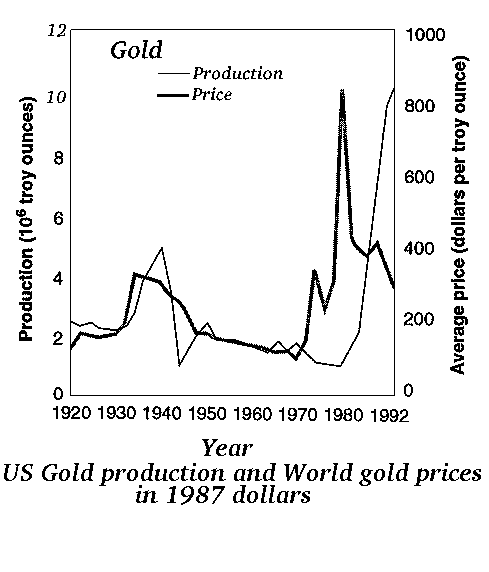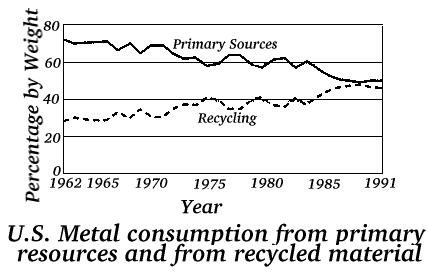Mineral Resources
Mineral Resources
back to Contents of Entire Course...
Reserves vs. Resources
Factors involved in
deciding whether to mine a potential ore body
The Rise of Recycling
Environmental
Problems associated with various aspects of Mining
adapted to HTML from lecture notes of Prof. Stephen A. Nelson Tulane University
Reserves vs. Resources
Reserves - Are dependent on price. Resources - Total amount of material present.

(Notice that the production of gold roughly followed the price of the gold. In 1980 the price of gold drastically went up and very shortly after that we see a sharp increase in gold production. This sharp increase reflects the addition of other gold sources that were previously thought too costly to use.)
Typically a gold mine may contain 10 grams (one-third of an ounce) of gold per ton of ore mined.
Factors involved in deciding whether to mine a potential ore body
- Price of commodity
- Size of ore body
- Cost of capital investment
- Underground vs. Surface Mining ( underground mining is much more expensive generally will only do this if there is a seam or if the ore can be sold at a high price)
- Extent of mineral processing necessary (eg- 8 g of gold is recovered from 1 ton of rock)
- Cost of mining
- Cost of transportation
- Cost of reclamation (returning land to previous pre-mining condition)
- Is there a market?
| Mineral Reserves and Resources | ||||
|---|---|---|---|---|
| Material | World Reserve 1,000 tons | World Lifetime Years | U.S. Reserves 1,000 tons | U.S. |
| Bauxite | 23,000,000 | 219 | 20,000 | 4.1 |
| Chrome | 1,400,000 | 109 | 0 | 0 |
| Iron | 150,000,000 | 178 | 16,100,000 | 244 |
| Nickel | 47,000 | 51 | 23 | 0.2 |
| Platinum | 56,000 tons | 190 | 250 tons | 2.2 |
| Gold | 44,000 tons | 20 | 4,770 tons | 47 |
The Rise of Recycling
Notice how the consumption of metals has changed from a strictly primary source to a 50% primary source and 50% recycled source since about 1980.

Another overhead has to do with what % of scrap metal for a variety of different metals were used instead of mining new reserves. The below is a list of the findings.
| Metal | % of scrap metal used |
|---|---|
| Al | 40 |
| Cu | 42 |
| Fe | 55 |
| Pb | 70 |
| Zn | 30 |
| Sn | 30 |
Environmental Problems associated with various aspects of Mining
- Exploration - Need to put in roads, cut lines through woods, etc.
- Mining
- Underground - Not as bad, except that sometimes hazardous materials are removed.
- Surface - Pit or strip mine. Can cover very large tracrts of land.
- Processing
- Waste materials need to be disposed of, and are often toxic.
- Smokestack - Ejects toxic material into the atmosphere.
Sulfides are common - Arsenic, lead, mercury, sulfuric acid.

